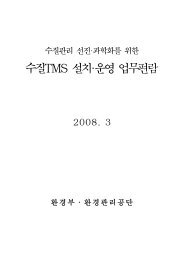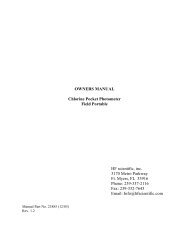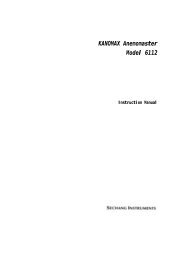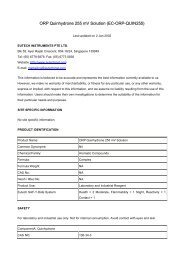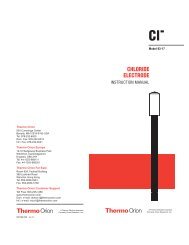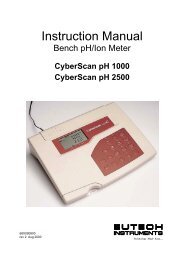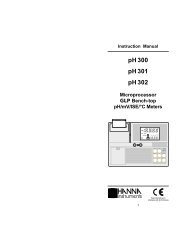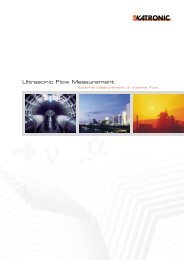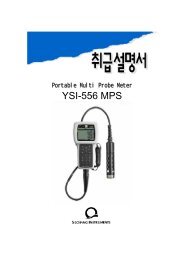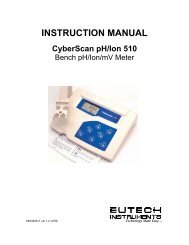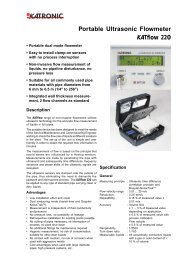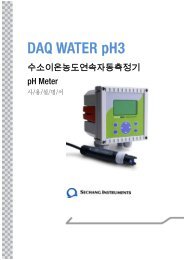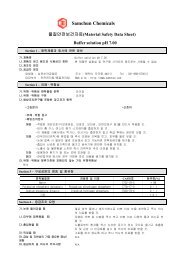MODEL 2100AN LABORATORY TURBIDIMETER INSTRUMENT ...
MODEL 2100AN LABORATORY TURBIDIMETER INSTRUMENT ...
MODEL 2100AN LABORATORY TURBIDIMETER INSTRUMENT ...
Create successful ePaper yourself
Turn your PDF publications into a flip-book with our unique Google optimized e-Paper software.
SECTION 3, continued<br />
3.1.3 Using the SIGNAL AVG Key<br />
Turning on Signal Averaging causes a number of measurements to accumulate in<br />
a measurement data storage buffer. The number of measurements stored and used<br />
for displaying the average reading can be specified by the analyst (between 1 and<br />
15 readings). Three measurements are averaged with Signal Averaging off. The<br />
initial value is updated immediately with Signal Averaging on. Subsequent values<br />
are an average of readings accumulated in the buffer. As the buffer accumulates<br />
the number of readings specified, the display shows the cumulative average.<br />
3.1.4 Using the FLOW Key<br />
3.1.5 Using the LINE FEED Key<br />
3.1.6 Using the RATIO key<br />
Press SETUP to change the number of readings used for the Signal Averaging<br />
mode (set at 10 initially). One of the green LED digits in the mode display begins<br />
to flash. Press the up, down and right arrow keys to select the setup number 09.<br />
Press ENTER. Next, enter the number of signal averages using the edit keys.<br />
Press ENTER to accept the number of readings displayed. Press SETUP to exit the<br />
setup mode. Pressing UNITS/Exit at any time, prior to accepting the new value,<br />
exits the setup mode leaving original values intact. The largest acceptable Signal<br />
Averaging number is 15; the instrument uses 15 measurements if a larger number<br />
is specified.<br />
Pressing ENTER when Signal Averaging is selected on clears the data buffer<br />
and provides an immediate update. If power is turned off and then restored,<br />
the instrument re-initializes to the Signal Averaging condition selected during the<br />
last measurement.<br />
Press the FLOW key to enter or exit the automated FLOW mode that is used in<br />
conjunction with the automated Flow-Cell system. Refer to Section 5.2.2 on<br />
page 54 for more information.<br />
Press the LINE FEED key to advance the internal printer paper one line each time<br />
the key is pressed.<br />
TurnRatioonandoffbypressingtheRATIO key. A lighted annunciator indicates<br />
the Ratio function is selected on. A flashing annunciator light and 9s on the large<br />
LED display indicate that the measurement is greater than 40 NTUs and the Ratio<br />
mode is selected off. Press the RATIO key to clear the over-range condition; the<br />
Ratio annunciator is lighted.<br />
With Ratio on, the 90°, transmitted and forward scatter detectors are used to make<br />
the measurement. When NTU values greater than 4000 are measured, the back<br />
scatter detector signal is incorporated into the measurement.<br />
Measurements with Ratio on and measurements with Ratio off are nearly<br />
equivalent for turbidity measurements less than 40 NTU if interferences due to<br />
color or light absorbing particles are not present. However, Ratio on compensates<br />
for instrumental and sample variables. Operation with Ratio on is recommended<br />
for most measurements. Refer to Section 1.3 on page 11 for a more detailed<br />
discussion of Ratio on vs. Ratio off measurements.<br />
34



